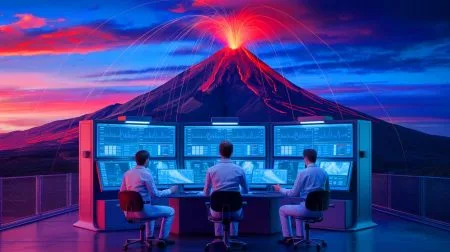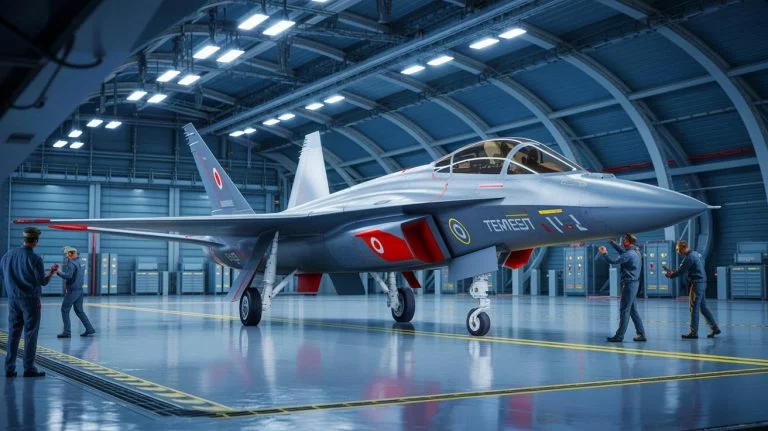| IN A NUTSHELL |
|
The unveiling of the sixth-generation fighter demonstrator by BAE Systems marks a pivotal moment in military aviation. Developed under the Global Combat Air Programme by the UK, Italy, and Japan, this groundbreaking project, known as Tempest in the UK, is set to revolutionize air combat technology. With its operational debut expected in 2035, the demonstrator aims to replace the Typhoon Eurofighter and surpass the capabilities of the F-35 Lightning II. The journey to this point reflects an ambitious collaboration driven by cutting-edge technology and strategic foresight, promising to redefine the future of aerial warfare.
The Evolution of Air Combat Technology
BAE Systems’ Tempest project is part of a broader effort to usher in a new era of air combat technology. As the first fighter to be constructed in Britain in over four decades, it symbolizes a significant leap forward in military aviation. The Tempest aims to incorporate innovative features that push the boundaries of what was once considered science fiction. This includes advanced stealth capabilities, modular design for quick upgrades, and integrated artificial intelligence and machine learning systems. Such features aim to enhance the aircraft’s adaptability and effectiveness in diverse combat scenarios.
Moreover, the Tempest’s design emphasizes pilot-optional operation, allowing for both manned and unmanned missions. This flexibility is crucial in modern warfare, where quick adaptation to changing threat landscapes is vital. The aircraft’s virtual cockpit and Loyal Wingman controls further underscore its role as a command and control hub for drone swarms. This modular approach not only enhances its operational capabilities but also ensures that it remains at the cutting edge of technology long after its initial deployment.
Innovative Manufacturing Processes
The construction of the Tempest demonstrator showcases a suite of advanced manufacturing techniques that are pivotal to its success. BAE Systems has utilized digital manufacturing methods, including 3D printing for rapid prototyping and the simplification of components. These techniques allow for faster development cycles and reduced costs, enabling more efficient production. The use of digital twins and model-based systems engineering facilitates virtual simulations, ensuring that potential issues are identified and addressed early in the development process.
Furthermore, the incorporation of cobotics—robots designed to work safely alongside human workers—enhances the manufacturing process by increasing precision and efficiency. This collaborative approach not only speeds up production but also improves safety standards in the workplace. Combined, these innovations are setting new benchmarks in aerospace manufacturing, promising to deliver an aircraft that is not only advanced but also cost-effective and reliable.
Challenges and Opportunities Ahead
The path to developing the Tempest is fraught with both challenges and opportunities. One of the primary hurdles is ensuring that the aircraft meets the ambitious performance targets set by its developers. This includes achieving twice the payload capacity of the F-35A and the ability to conduct transatlantic missions without refueling. Meeting these goals requires not only technical prowess but also strategic collaboration among the participating countries.
However, the potential rewards are significant. By spearheading this project, the UK, Italy, and Japan are positioning themselves at the forefront of military aviation. The Tempest program not only promises to deliver a state-of-the-art fighter but also aims to bolster industrial capabilities and workforce readiness. As Tony Godbold, Future Combat Air Systems Delivery Director at BAE Systems, noted, “The program is accelerating the development of advanced design approaches and manufacturing techniques, helping to sharpen the UK’s industrial edge and deliver benefits beyond the production of the aircraft.”
The Future of Aerial Warfare
As the Tempest moves closer to its first flight, it represents a significant step forward in the evolution of aerial warfare. The demonstrator aircraft, expected to take to the skies in 2027, will play a crucial role in testing and refining the technologies that will define the production model. Its success will likely dictate the trajectory of future military aviation programs worldwide.
With its advanced capabilities and innovative design, the Tempest is poised to shape the future of aerial combat. The integration of energy weapons and hypersonic launchers further enhances its strategic value, offering new possibilities for defense and deterrence. As the world watches the progress of this ambitious project, one must consider how these advancements will influence global military dynamics. How will the Tempest and similar programs redefine the balance of power in the skies, and what implications will this have for international security and cooperation?
Did you like it? 4.3/5 (23)





Wow, the Tempest sounds like something out of a sci-fi movie! When can we expect to see it in action? 🚀
2027 for demonstrator tests *
2035 for entering service *
(* planned)
Is anyone else concerned about AI taking over military decisions? Seems like a slippery slope… 🤔
Great to see international collaboration on such a project! Hope it leads to more peace, not conflict.
3D printing fighter jets? What’s next, printing our dinner? 😂
When do you think other countries will start developing their own sixth-gen fighters?
AI in combat aircrafts… what could possibly go wrong? 🤯
How will the Tempest perform in adverse weather conditions? Will it still be effective?
The virtual cockpit feature is fascinating. But how safe is it for pilots? 🤔
Very,
Because it is designed to be flown manned or unmanned .
Why is Japan involved in this project? Are they moving away from their pacifist stance?
Exciting times for aerospace! Can’t wait to see what the Tempest can do in 2035!
AI, drones, and stealth capabilities – sounds like a video game!
How will the Tempest impact the global arms race? Will it set off a new wave of developments?
What measures are in place to prevent hacking into these AI systems?
How does the Tempest compare cost-wise to the F-35 Lightning II? Is it more efficient?
Really looking forward to seeing the Tempest in action. The future is now! 😎
Is anyone else worried about the ethical implications of AI in warfare? 🤔
How will the Tempest’s Loyal Wingman controls work exactly? Will it require human oversight?
More planes, more problems! Let’s focus on peace for a change! 🌍✌️
The idea of unmanned missions is both exciting and terrifying!
Can the Tempest’s technology be applied to commercial aviation too?
BAE Systems really pushing the boundaries of technology here! Impressive!
What kind of energy weapons are we talking about? This sounds like something from Star Wars! 😲
Why is the UK so focused on this project? Are there geopolitical reasons behind it?
The stealth capabilities of the Tempest must be top-notch. Are they better than the F-35?
Less talk, more action! When’s the first flight scheduled? ✈️
With all these features, what will the Tempest’s maintenance look like? Will it be sustainable?
AI integration is cool, but how do we ensure it’s not a target for cyber attacks?
Here’s to hoping the Tempest doesn’t just become another expensive toy for governments… 👀
BAE Systems is setting the stage for the next era of combat aviation. Truly revolutionary!
Digital twins and cobotics? Sounds like a tech overload! Is this really necessary?
Does anyone else feel uneasy about this arms race? The world doesn’t need more weapons.
The Tempest programme was announced in 2015 ! With Development starting in 2018.
The first technology demonstrator airframe is now under construction, due for flight testing in 2027. 2/3 rds of the structural weight is already under construction.
BAE and Raf test pilots have already clocked over 300hrs of simulated flights in a high fidelity simulator, providing crucial design input.
Should be entering service ≈2035 when it will fully replace the Typhoon.
Rolls Royce is developing the next generation of engines which will produce 10 times the electricity output of Typhoon engines. It’s advanced radar and sensor arrays are planned for 10,000 times the data of current highest systems.